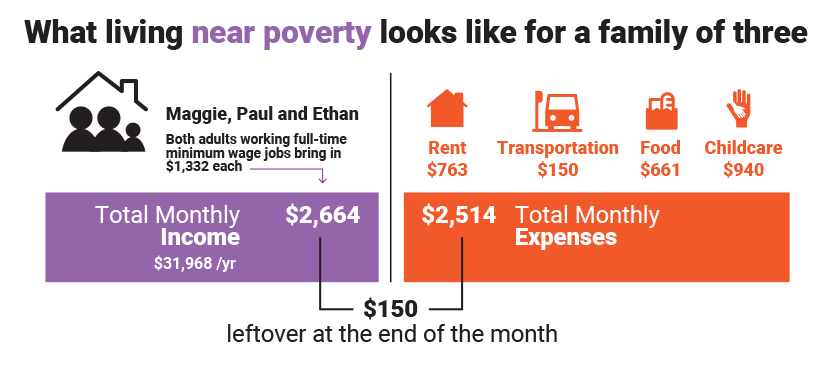Seniors 75+
While most economically vulnerable seniors in Buffalo Niagara are homeowners, many are aging alone on fixed incomes and have difficulty getting around.
Nearly 338,000 individuals across Buffalo Niagara live in or near poverty, on incomes less than 200% of the Federal Poverty Level. This represents 31% of Buffalo Niagara’s population, the same today as it was in 2011.
Individuals living in or near poverty face a variety of challenges. Those in need include single parents balancing child rearing with job demands, and families making ends meet on low-paying or part-time jobs. Children living in or near poverty often lack access to basic services and opportunities to cultivate their skills and talents and find career pathways out of poverty. Many seniors living on fixed incomes can’t afford unexpected expenses for homes and vehicles. Young adults struggle to find steady, higher-paying work, and refugees and immigrants face communication barriers and are not always aware of the resources available to them.
The stories of these individuals, backed by data, shed light on the challenges they face, as well as opportunities for potential solutions.
31% of Buffalo Niagara residents live in or near poverty.
Individuals and families who live in or near poverty often struggle to make ends meet on their incomes. Those with incomes up to 200% of the federal poverty level often qualify for programs and services that help with food, utilities, childcare, health insurance, medical care and more.
The federal poverty level varies by household size. Those considered “near poverty” have incomes up to 200% (or two times) the federal poverty level. Someone working full-time at minimum wage in NYS earns $23,088 annually.

Maggie, Paul and their two-year old son Ethan offer an example of a family near poverty. Both adults work minimum wage jobs, and together they earn about $32,000 a year or $2,664 a month to live on.
Rent consumes almost a third of their income. The cost of food trails behind. Daycare is the biggest expense. They put their son in daycare to maintain their jobs and access to benefits. After rent, food, childcare, and transportation, the family has $150 a month leftover to cover everything else.

While most economically vulnerable seniors in Buffalo Niagara are homeowners, many are aging alone on fixed incomes and have difficulty getting around.
With nearly 100,000 living in or near poverty, children make up the largest economically vulnerable population group in the region.
Most single parents in the region are employed or looking for work, but relatively few have a college degree that could their improve job opportunities.
Two-thirds of recent refugees and immigrants in Buffalo Niagara live in or near poverty.
Low wages and limited work hours can make working families economically vulnerable.
Many young adults without children struggle due to limited education and low-wage jobs.

Over 60,000 households in the region do not have a vehicle and rely on alternative ways of getting around.

Approximately 70% of lower-income households are housing cost burdened (paying more than 30% of their income on housing).

Consumer debt is the number one financial challenge many lower-income residents face. Debt makes it difficult to save for a down payment on a mortgage or for a small emergency fund. Poor credit can also limit job opportunities.

More than half of jobs across the region pay less than $40,000 a year. This is less than 200% of the Federal Poverty Level for a family of three.

16% of households are served by the federal Supplemental Nutrition Assistance Program (SNAP). Yet having enough money for food is a top urgent concern reported by residents in some communities.

Over 5,000 juveniles were arrested across Buffalo Niagara over the most recent five years.

More than half of adults across the region did not continue their education beyond high school.

Drug addiction, isolation and trauma are some of the most common mental health concerns identified across Buffalo Niagara.
Over 200 human service providers and leaders use Numbers in Need to find information, build partnerships, pursue funding and advocate for their community.
“This data has been instrumental in finding what our community looks like and what obstacles we need to tackle to move ahead.”
“I have repeatedly and often share this data with colleagues and community members.”